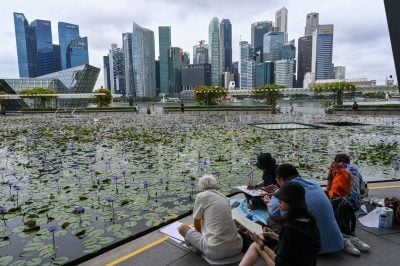This article was produced with the support of 1-54
On the occasion of 1-54 Contemporary African Art Fair’s 11th London edition, 1-54 are pleased to announce “Transatlantic Connections: Caribbean Narratives in Contemporary Art”, a group exhibition of modern and contemporary Caribbean artists on view at Christie’s, London, from 10 to 13 October 2023. Ahead of the exhibition, we spoke to Caryl Ivrisse Crochemar, the exhibition’s curator.
What can you tell us about this exhibition…
1-54 Presents is a curated exhibition programme that runs alongside 1-54 Contemporary African Art Fair. It offers a unique thematic exhibition. 1-54 Presents made its debut in New York in May, during 1-54 New York 2023, and this time the second iteration of the project will be held at Christie’s in London. The London 2023 exhibition is titled “Transatlantic Connections: Caribbean Narratives in Contemporary Art” and brings together artworks from some of the most exciting modern and contemporary Caribbean artists of the last 50 years.
You curated an exhibition called “Sparkling Islands, Another Postcard of the Caribbean” for 1-54 in New York earlier this year. How does this exhibition differ?
1-54 presented “Sparkling Islands: Another Postcard of the Caribbean” in New York – a groundbreaking endeavour that represented a new addition to the fair’s framework. The innovative platform was conceived in collaboration with fair directors Touria El Glaoui and Camille Ostermann. Its primary mission was to illuminate the rich tapestry of the global African diaspora, embracing diversity in all its forms.
Our collective decision led to the creation of a thematic exhibition that pays homage to the invaluable contributions of Afro-descendant Caribbean artists within both the Caribbean art landscape and the global artistic sphere. This endeavour celebrates their artistic prowess, underscoring their significance and influence. The exhibition itself showcased the works of 13 remarkable artists, offering a captivating array of artistic expressions encompassing paintings, photography, sculpture, ceramics, works on paper, and installation art.

Shifting our focus to 1-54’s presentation in London: while the narrative remains consistent, there are notable distinctions. Foremost among them is the notable increase in the number of participating artists. In this edition, we are thrilled to present the works of 22 artists, with an impressive representation of 12 women artists among them. This expansion signifies a commitment to further diversify and amplify the voices of the African diaspora within the realm of contemporary art.
What are some of your goals with this exhibition? What do you want audiences to take away from the show?
The primary objective is to foster connections and sustain the dialogue initiated by the fair, spanning its various editions and associated programs.
The exhibition “Transatlantic Connections: Caribbean Narratives in Contemporary Art” serves as a prominent tribute to the invaluable contributions of Caribbean artists in contemporary art over recent decades and the present era. Additionally, it pays homage to the community in the UK, especially as they commemorate the 75th anniversary of the arrival of the MV Empire Windrush in the UK.

“Transatlantic Connections: Caribbean Narratives in Contemporary Art” aims to cast a spotlight on and to celebrate the significant creative contributions of Afro-Caribbean artists to the cultural tapestry of their adopted homelands and the broader global stage.
On a personal note, my aspiration for this exhibition is twofold. Firstly, I hope it provides the public with an opportunity to discover and appreciate the talents of these artists and the profound impact their artistic practices have had on British contemporary art and beyond. Furthermore, it seeks to educate both the general public and the art-informed audience about the evolution of contemporary art in the Caribbean, as viewed through the diverse accomplishments of artists from this vibrant archipelago.
The artist list is extremely varied, from older post-war masters to younger, emerging artists working from different locations around the world.
Was variety important to you when curating the exhibition?
The exhibition spotlights just a fraction of the Caribbean’s rich visual arts community, bringing together 22 artists with diverse Caribbean backgrounds, hailing from places as distant as Barbados, Cuba, Guadeloupe, Jamaica, Martinique, St. Vincent & the Grenadines, The Bahamas, Trinidad & Tobago, France, the US, and, of course, the UK.
These artists, with their undeniable talent and increasing visibility, play a significant role in advancing Caribbean art through their careers and innovative artistic approaches, showcasing success stories that contribute to the broader recognition of Caribbean art.

The exhibition’s concept is deeply rooted in Aimé Césaire’s notion of négritude, which emphasises the shared identity, consciousness, and culture among black peoples; and by Édouard Glissant’s theory of The Rhizome. Therefore, it is only natural to showcase the immense diversity of Caribbean creativity, aiming to challenge persistent stereotypes and misconceptions about the region.
Fostering attention and awareness of art, in all its diversity and discourse, among the local population across the archipelago is of utmost importance. Simultaneously, the exhibition seeks to provide global audiences with access to this vibrant art scene, nurturing a deeper understanding of the Caribbean’s multifaceted cultural contributions.
Why are exhibitions focused on artists from particular regions still important?
Exhibitions featuring artists from particular regions remain relevant because they celebrate cultural diversity, challenge stereotypes, promote cross-cultural understanding, and facilitate artistic exchange. While it’s important to support artists from all over the world, regional exhibitions play a vital role in enriching the global art scene and fostering a more inclusive and interconnected cultural environment.
Find out more about the 1-54 Contemporary African Art Fair in London.
 Sign in with Google
Sign in with Google 



